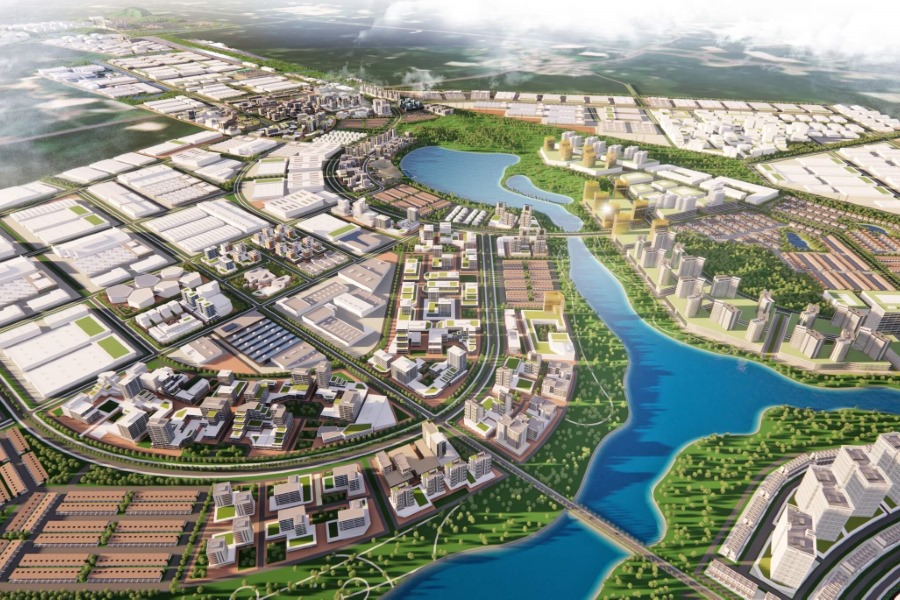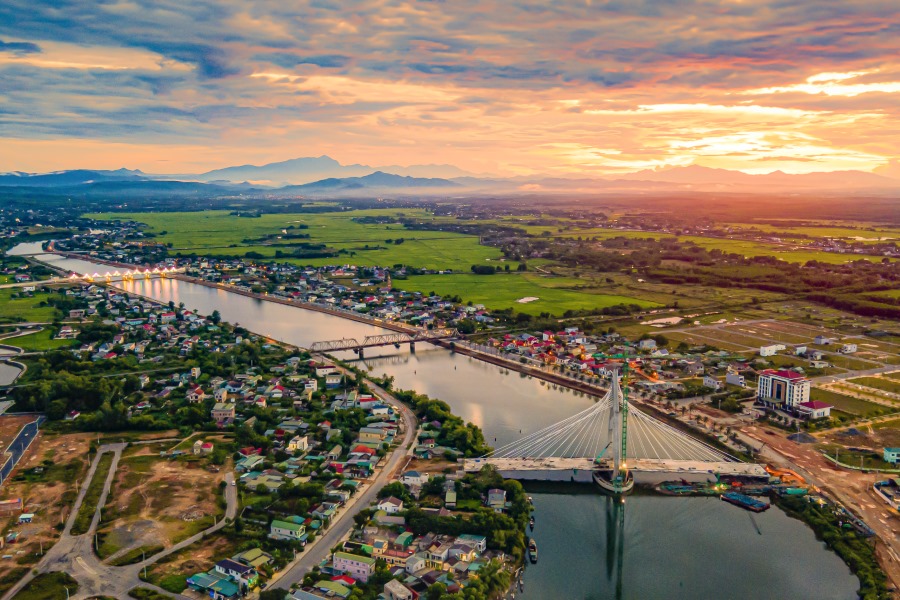QUANG TRI – A PLENTIFUL PROVINCE
The master plan vision that balances conservation, development, and innovative resilience
LIM SIAH GIM, FENG LUYE
SJ PLANNING
NOVEMBER 2023
Sunset at the river at Dong
Ha City, capital of Quang Tri
province
Abstract: Quang Tri (QT) is one of the least developed and least populated provinces in Vietnam.
As a province with limited financial resources and many critical infrastructures to invest in, the
Concept Masterplan (CMP) prioritised the integration and optimisation of investments for economic,
urban development and job creation. The approved CMP will act as the basis for the local design
institute (LDI) to prepare the actual CMP submission to the Provincial government and Prime
Minister for final approval. When approved, the CMP would be the guide for planning and
development of the entire province up to 2030. This is accounting for ever-changing socioeconomic
needs of the region. The CMP will be reviewed and updated every 5 to 10 years as needed.
BACKGROUND
QT is one of 63 provinces of Vietnam, located within North Central Coastal Region of Vietnam with a
population of 638,219 (as of 2020) and a total area of 4,701 sq.km. It is sandwiched between the
Quang Binh and Thua Thien Hue province on its north and south, and the Laos People’s Democratic
Republic and South China Sea on its west and east. As the east “Bridgehead” of the East -West
Economic Corridor (EWEC), QT connects Vietnam to Laos, Thailand and Myanmar. It’s also at the
intersection of the EWEC and North-South Economic Axis (NSEA) of Vietnam.

Location of Quang Tri in the region
Gauging Opportunities and Challenges
QT’s strategic location at the ‘Bridgehead’ of the EWEC makes it an ideal international marine time
seaport, acting as a service centre for the land logged Laos and a large portion of Eastern Thailand.
Together with the NSEA, QT is flourishing into a major transportation hub.
QT has diverse topography and ecology, from the bio-riches of the mountainous west to the fertile flood
plains in the east. It is a perfect place to transform into a high yield, high tech agricultural hub. QT also
sports a 75km long coastline with beautiful beaches suitable for tourism, along with rich marine fisheries
in the adjacent sea. However, due to its geographical location, QT is susceptible to a variety of natural
disasters, such as floods, cyclones and landslides. This poses a challenge in protecting both citizens of
the region as well as built infrastructure in the area. The infrastructure is also underdeveloped, with
lacking critical amenities such as hospitals and institutional infrastructure. Additionally, the current
economic activities in the region do not yield high returns in terms of economic value (traditional
agriculture, forestry, fishery, etc.). It also lacks a steady stream of tourist footfall, making it one of the
poorest provinces in Vietnam. As a result, this has led to brain drain in the region, with talents opting to
move to other more developed or developing areas of Vietnam.
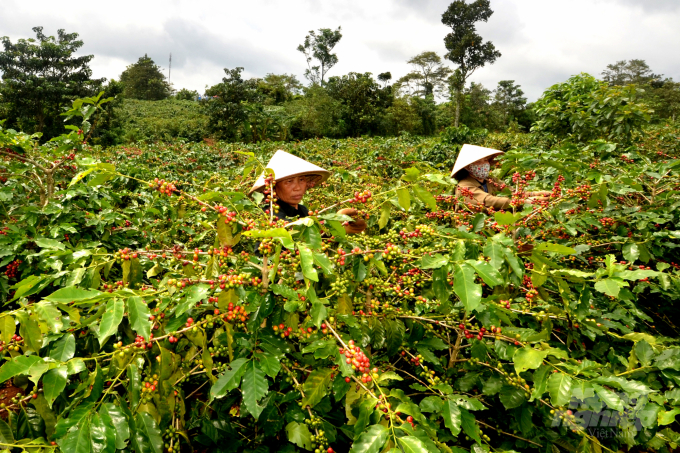
Coffee
farming at Khe Sanh, a
coffee-growing region with
more than a 100-year
history in Quang Tri
VISION
Through interaction with the resilient residents of
QT and understanding of QT’s history and goals,
we have forged a vision that encompasses the
strength of the people and their hopes for the future
generation. They desire environmental protection
due to its cultural importance, guidance for growth,
and an established future promising safety and
security. To achieve this, the CMP aims to strike a
balance between conservation and development,
tapping into the rich natural resources and labour
force of the region to drive growth.
QT is envisioned to be a “A Plentiful Province”, enshrining the Vietnamese model of inclusive and sustainable growth, anchored by resilience, innovation and a secure environment, providing boundless opportunities for all.
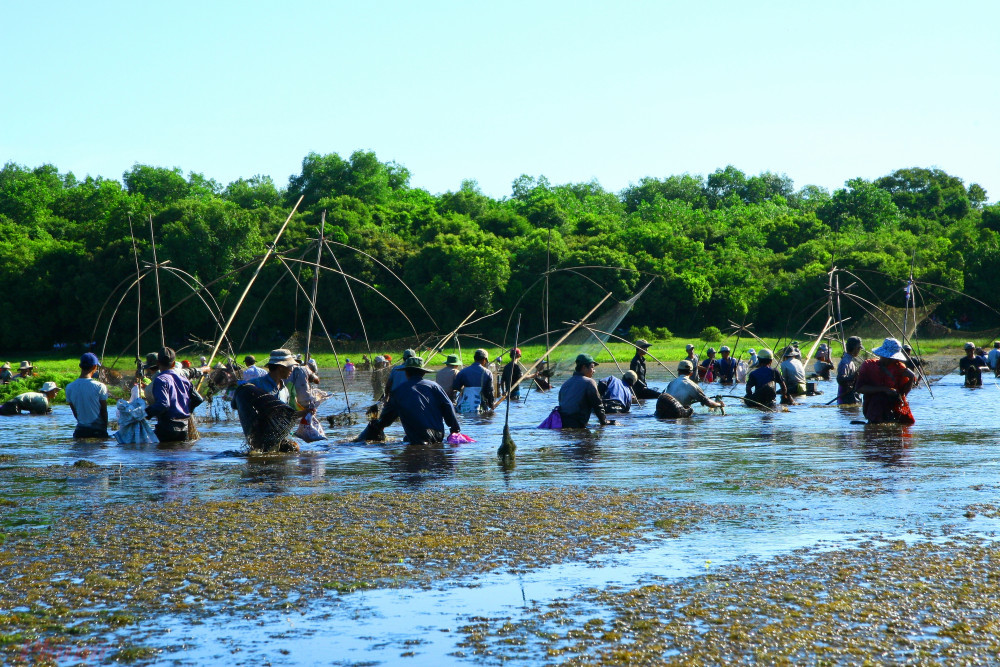
Fish
farming in Quang Tri
Planning with foresight and technological advancements at the forefront, the CMP aims to develop QT
into a resilient province with potential for endless innovation; one with infrastructure built to shield the
area from natural disasters and climate emergencies. It also aims to foster digital transformation
through providing incentive for research and development, with a focus on improving crop yields.
Combined with efficient and benevolent governance, this paves the way for establishing a safe and
liveable environment with a better future for all.
BASE MAP
To determine suitable land for urban and agricultural development, a base mapping exercise was
carried out. The base map used high resolution satellite images as the primary base and overlaid
multiple layers of data received including Natural Constraints, Environmentally Sensitive areas and
Human Intervention & Commitments.
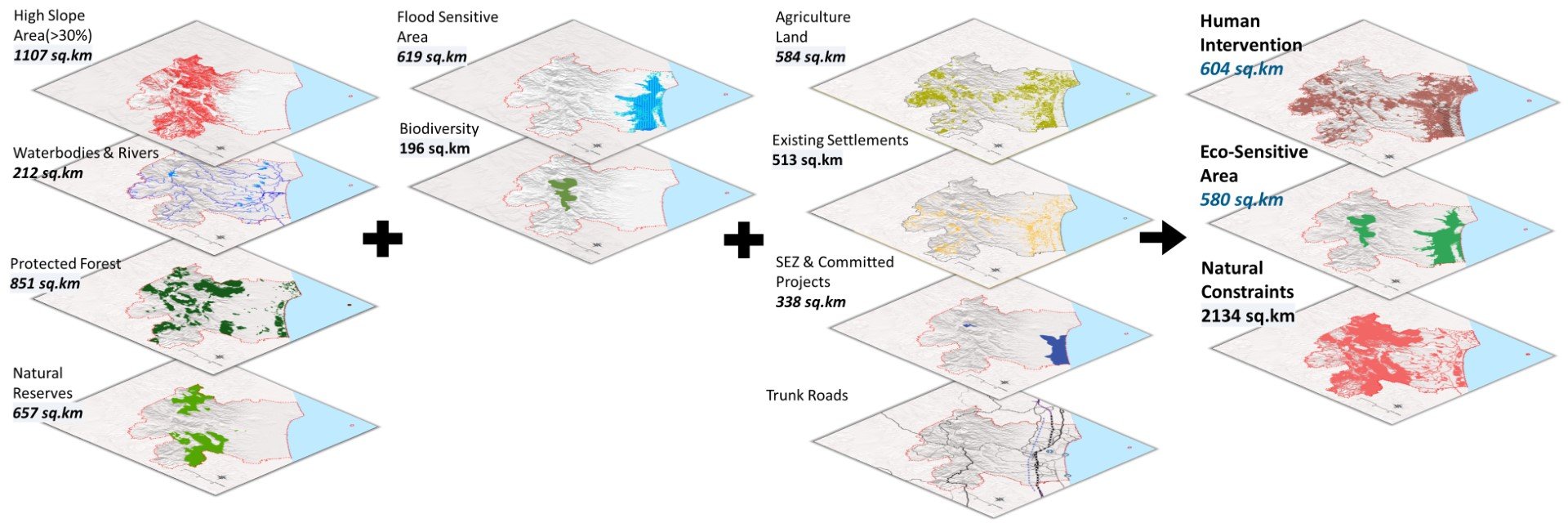
Quang Tri Land Developability Study Maps
Integrating all three layers/ categories above, it was determined 31.1% of the province or about 1,498
sqkm, was suitable for future development.
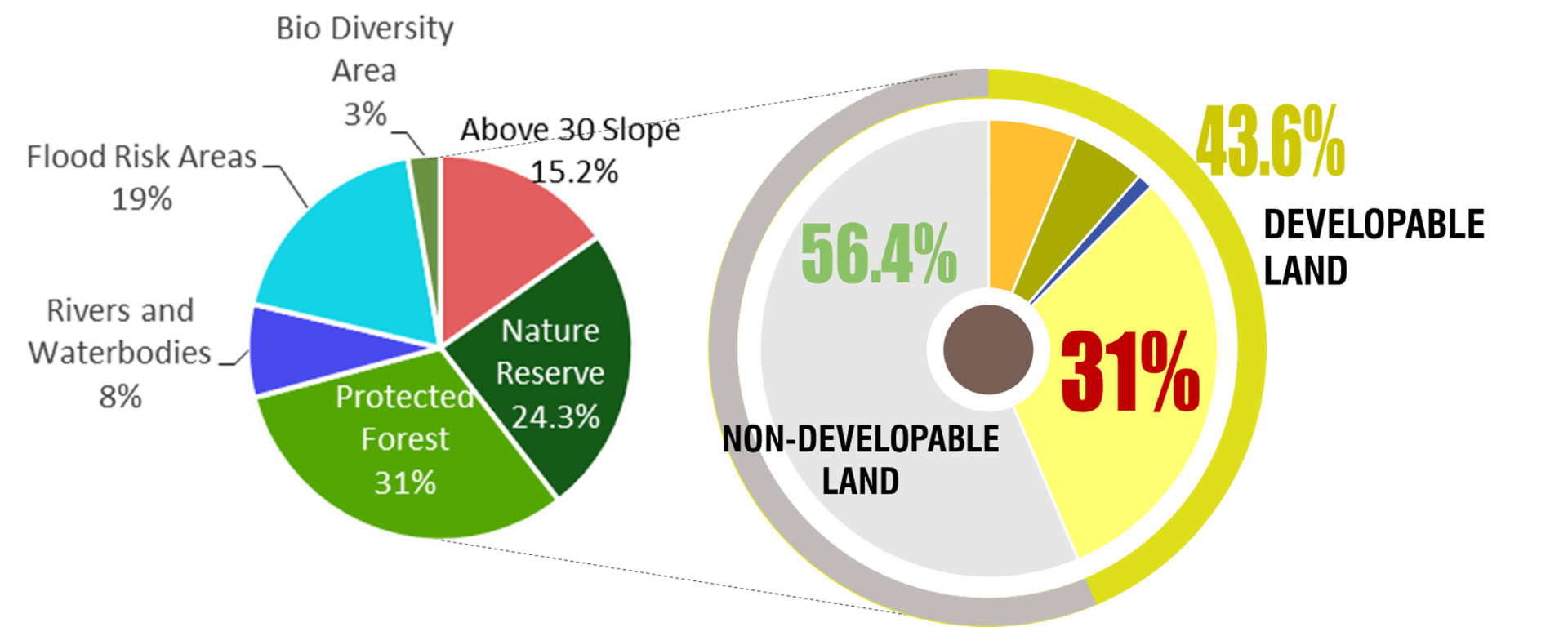
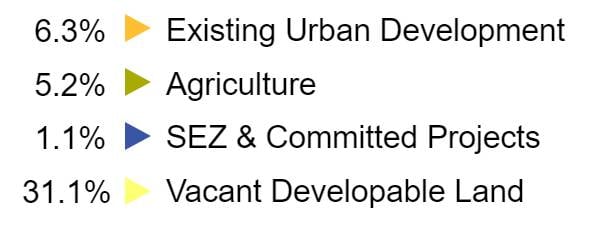
Quang Tri Land Developability Distribution Chart
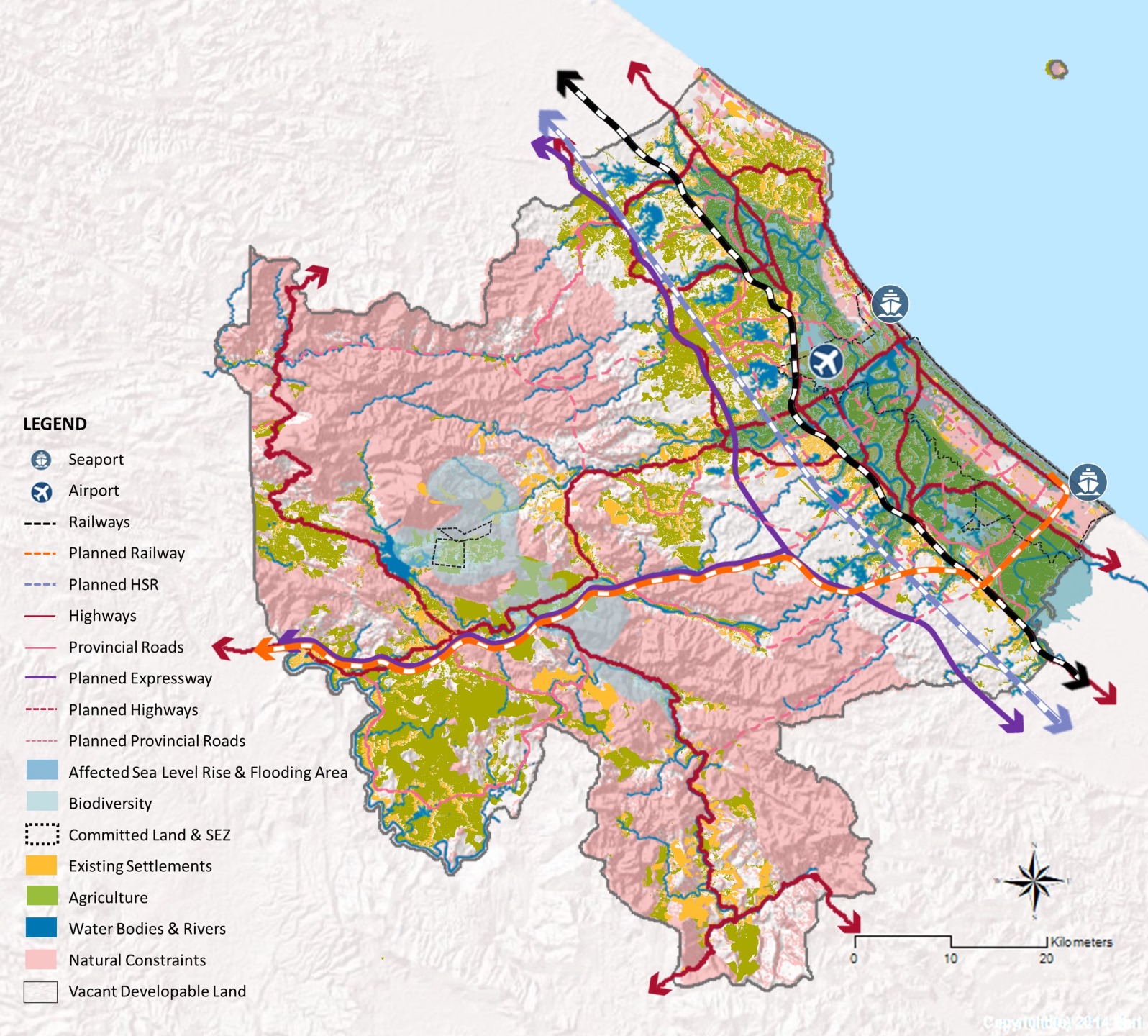
Quang Tri Constraints and Commitment and Vacant Developable Land Map
KEY STRATEGIES AND PLANS
The CMP encompasses 6 main strategies for development: Water Management, Coastal Protection,
Agricultural Development, Industrial Development, Tourism Development and Social Inclusion.
Water management
Due to its vulnerability to floods and other natural disasters, the CMP adopted a comprehensive and
integrated approach in proposing mitigation strategies. The three-pronged strategy involves: Western
reservoirs and dams, retention lakes in lowlands and flood zones, and dykes and barrages.
LAYER 1: WESTERN RESERVOIRS/ DAMS in upstream areas in west mountainous areas to reduce
water flow towards the flood plains during wet season. The reservoirs also act as a water source for
drinking water, a potential source of hydro-driven energy source, and a driver of eco-tourism.
LAYER 2: RETENTION LAKES IN LOW LAND & FLOOD ZONE focuses on expanding existing
retention lakes and create new large retention lakes (possibly 300 ha to 500 ha) in the flood zone to
protect surrounding land from flooding and to store water for irrigation combats droughts. Soil removed in
retention creation could be used to level up the low-lying land platform.
LAYER 3: DYKES AND BARRAGES: Dykes (earthwork or engineered) to above 100 years flood level
(in areas where coast level was lower than 100-year flood level) eliminates sea water intrusion to the
fertile plains, protect agriculture land & infrastructure and ensured a secured life for the people.
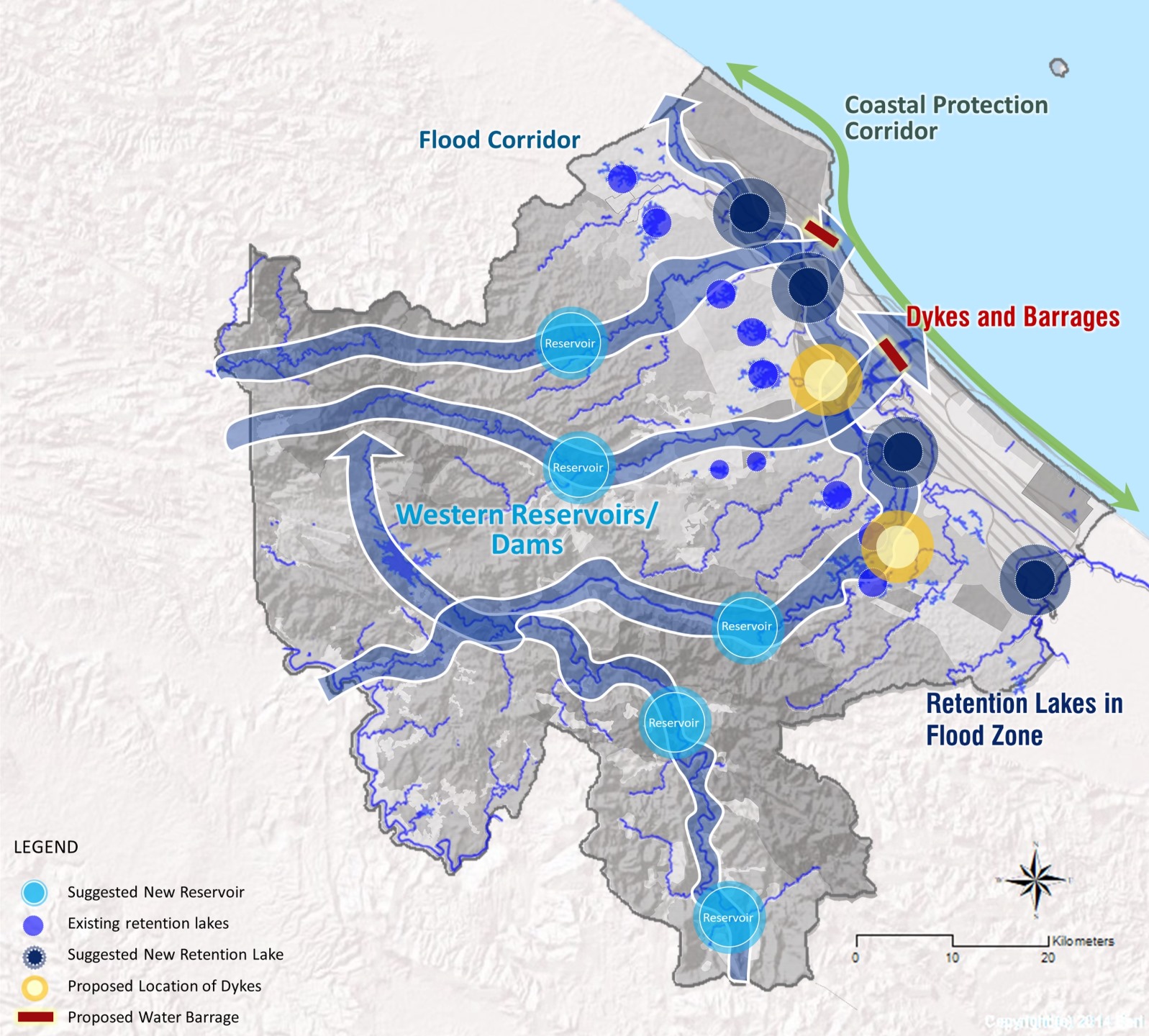
Quang Tri Overall Strategies And Structure Map For Flood Mitigation
Coastal Protection
QT boasts a 75km coastal belt with beautiful
beaches, though large portion of it was
subjected to serious damages from current
and climate change. Along areas with coast
higher than 100-year flood level, the CMP
proposed 3 methods of protection based on
the allowable land use were proposed:
coastal revetment or green buffer, a
cascading step planter and a hybrid
mangrove revetment. This aims to protect
the coastal area from floods and disasters
without compromising on the goal of coastal
preservation.
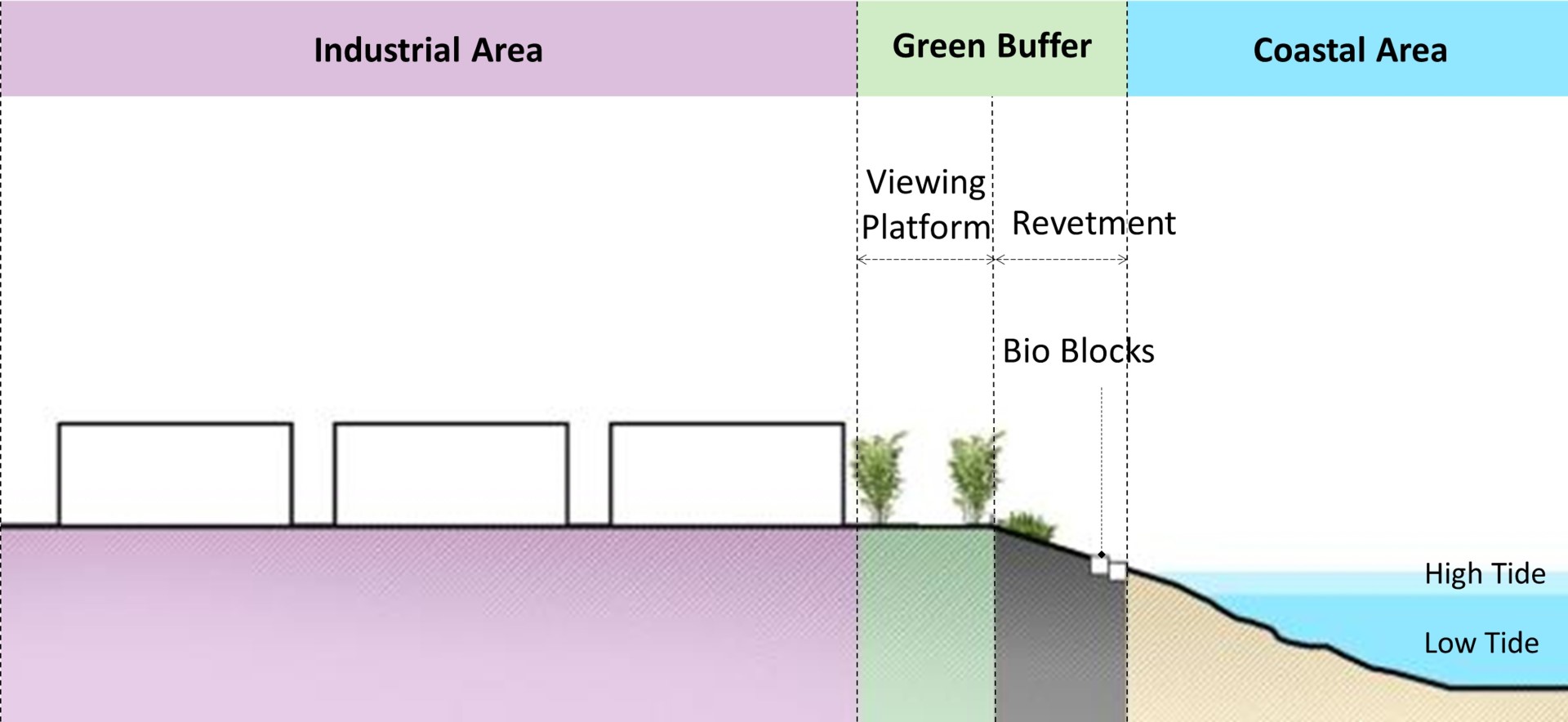
Coastal Revetment Section at Industrial Development Area
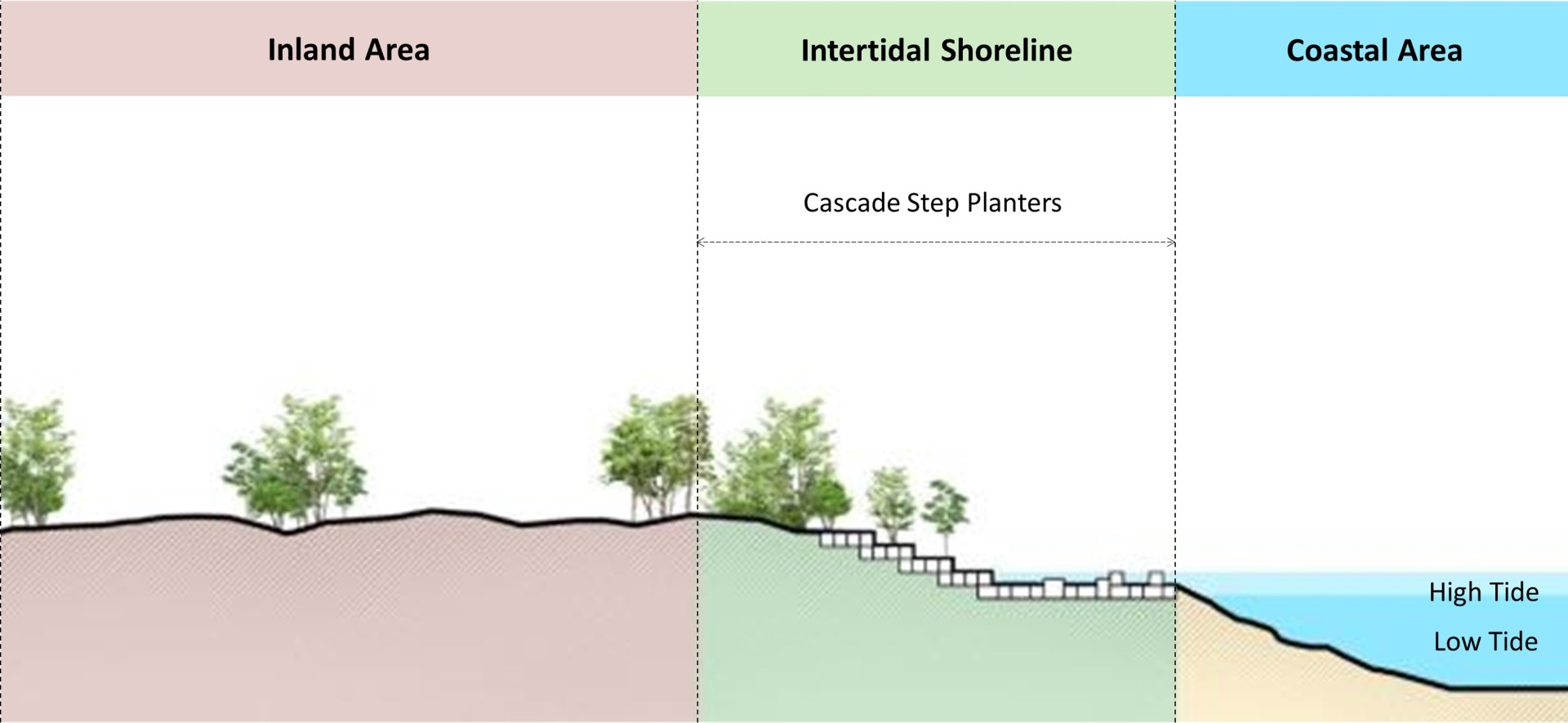
Cascade Step Planter Section in between Industrial And Eco Tourism Zone /
Hybrid Zone
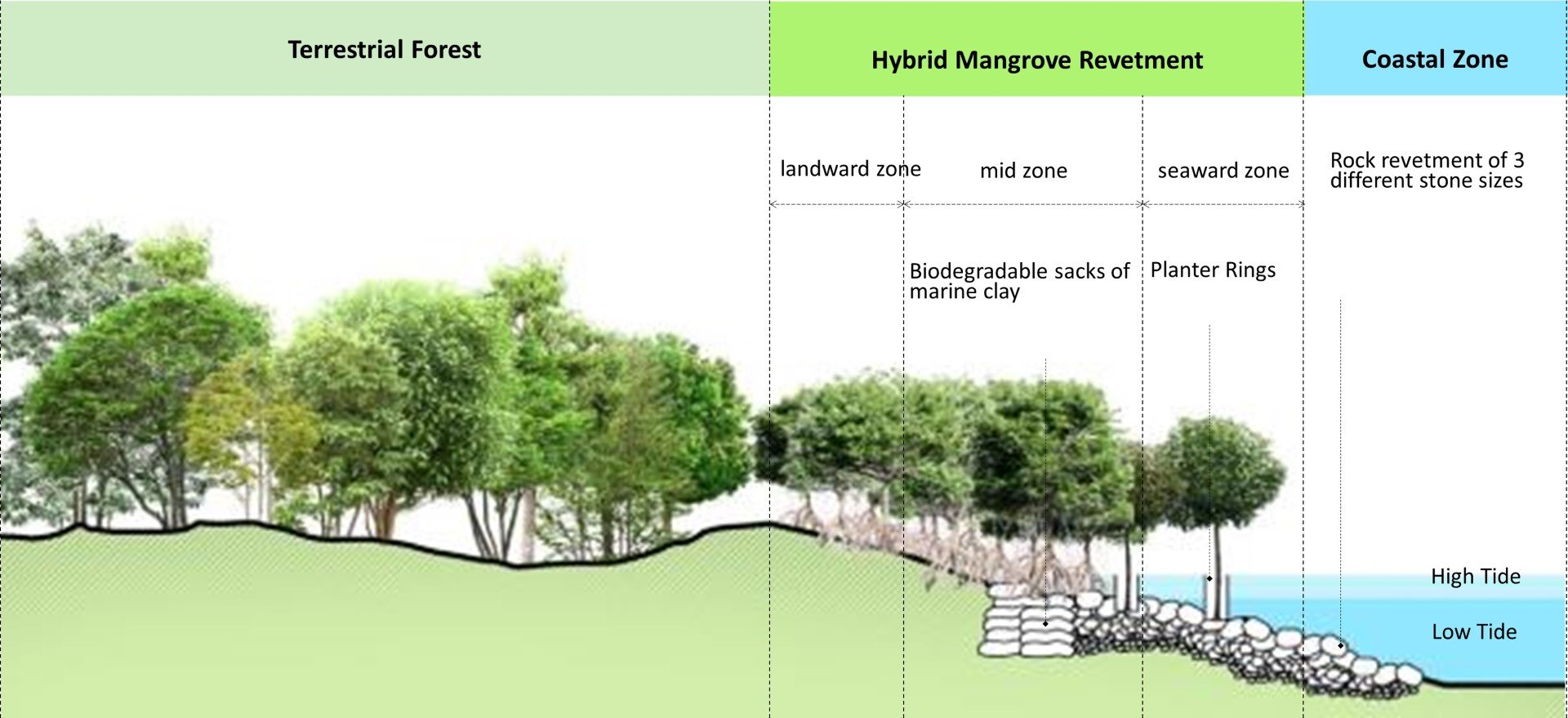
Hybrid Mangrove Revetment Section at River Mouth
To ensure clarity, a chart was formulated to facilitate understanding of the recommendations,
strategies in terms of environmental sustainability goals for the master plan.
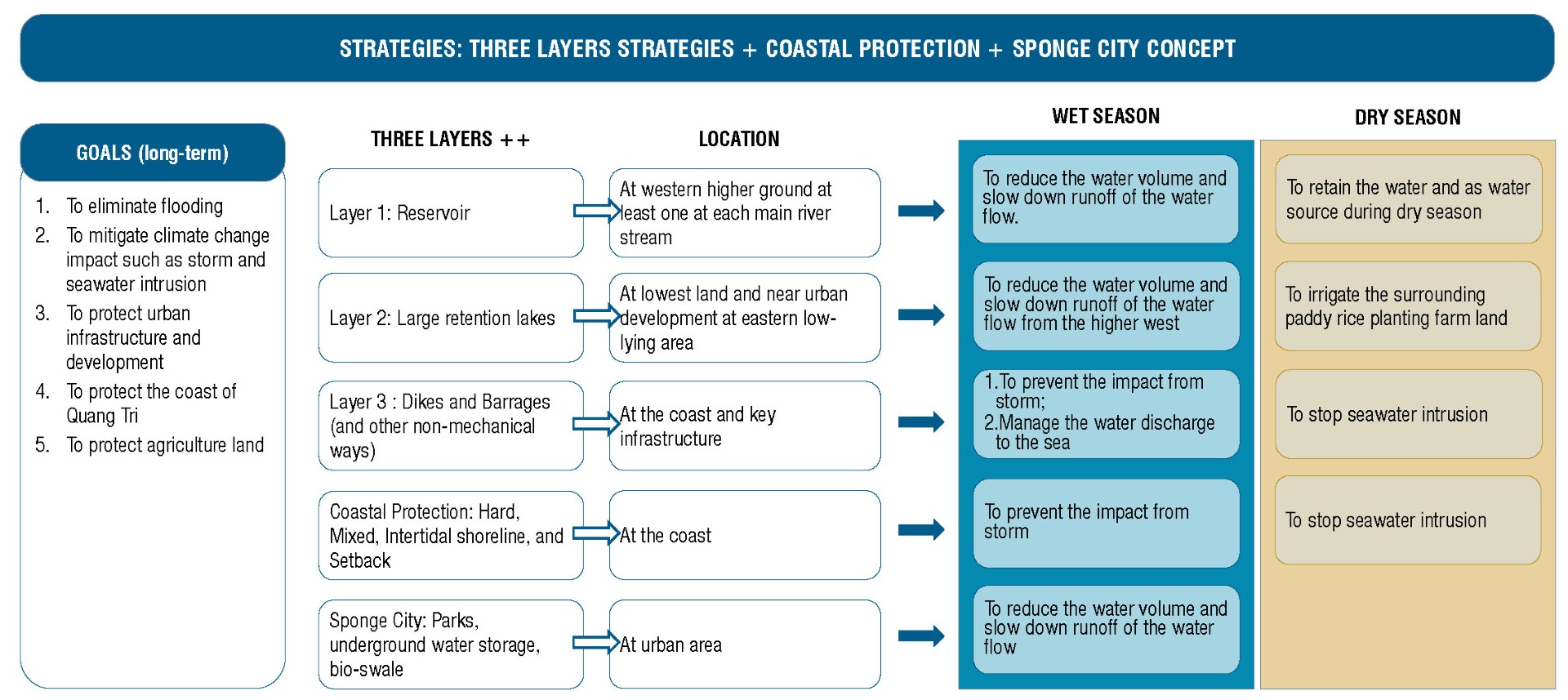
Overall Summary Chart for Flood Mitigation and Coastal Protection Strategies
Agricultural Development
As the food basket of the region in this region of Vietnam, agriculture (especially rice planting) is one of
the major economic activities in QT, with rice planted mostly in the flood plains. Farmers are working at
the mercy of the weather and a looming threat of sea water intrusion destroying the land. Water
management strategies, when implemented would ensure better control for the farmers, enabling more
secure income and better life.
Beyond rice planting, the CMP took advantage of QT advantages including availability of fertile land,
water and long agriculture tradition to propose 3 types agriculture land strategy with the following goals:
transition from a traditional agriculture economy to a high-tech agriculture economy, increase
productivity and yield with less reliance on manpower and introduce resilient agriculture to minimise
impact from climate change.
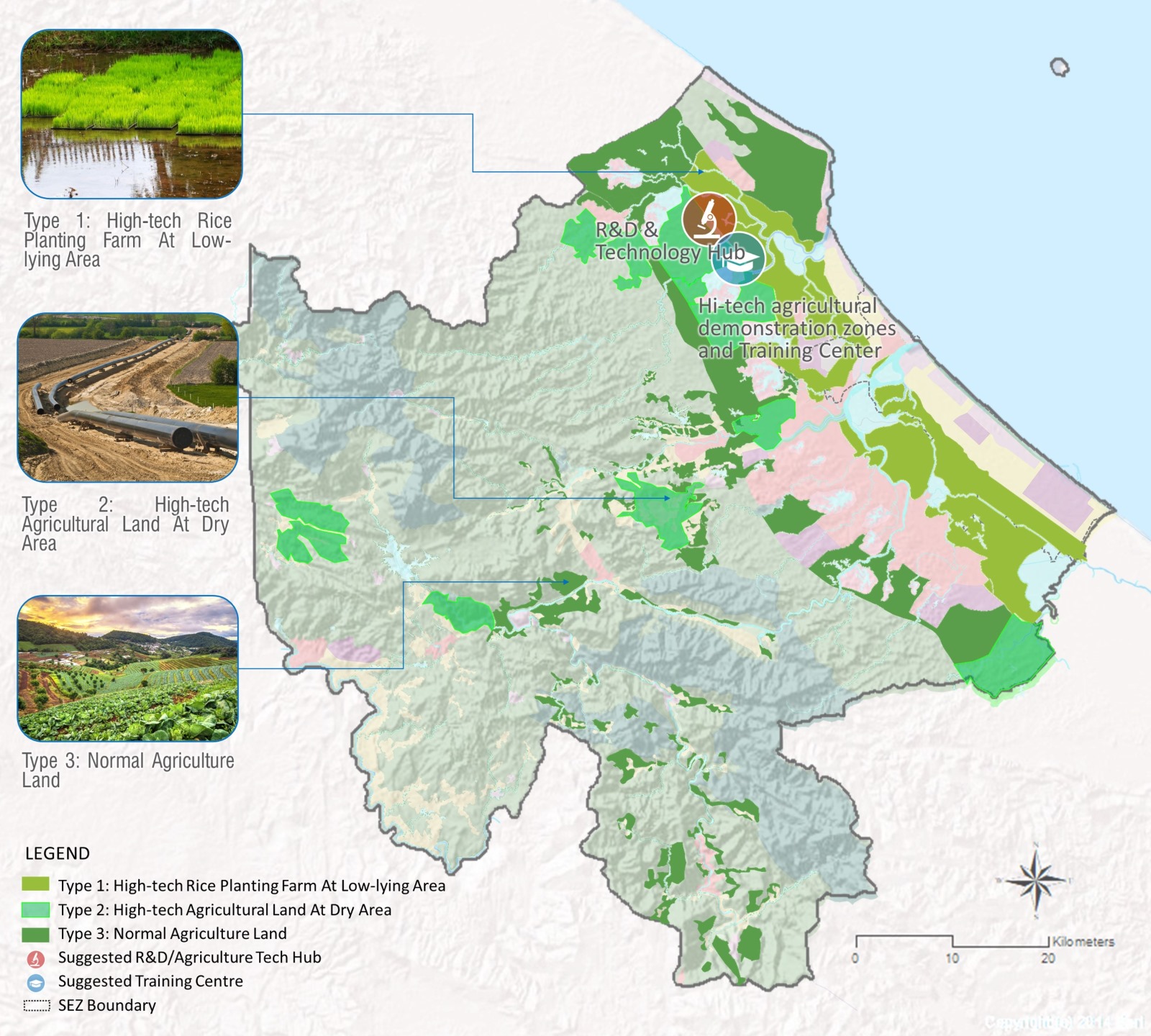
Proposed Agricultural Development Zones In Quang Tri
The strategy can be divided into 3 approaches: 1) at the flood plains, utilising technology and
high-yield seeds to increase yield, 2) establishment of high-tech farms at higher ground with good
accessibility to transport, water and housing, and 3) planting of high-value crops and providing training
and R & D facilities.
Industrial Development
The QT government aims to industrialise and leverage the benefits of the emerging digital
economy. The plans consist of consolidating
industrial parks, situating them away from flood
zones and closer to developed urban areas and
key infrastructural and transport nodes for easy
access and increased connectivity.
Key industrial parks include those around the airport, Lao Bao Economic Zone, at key transport gateways and regional hubs.
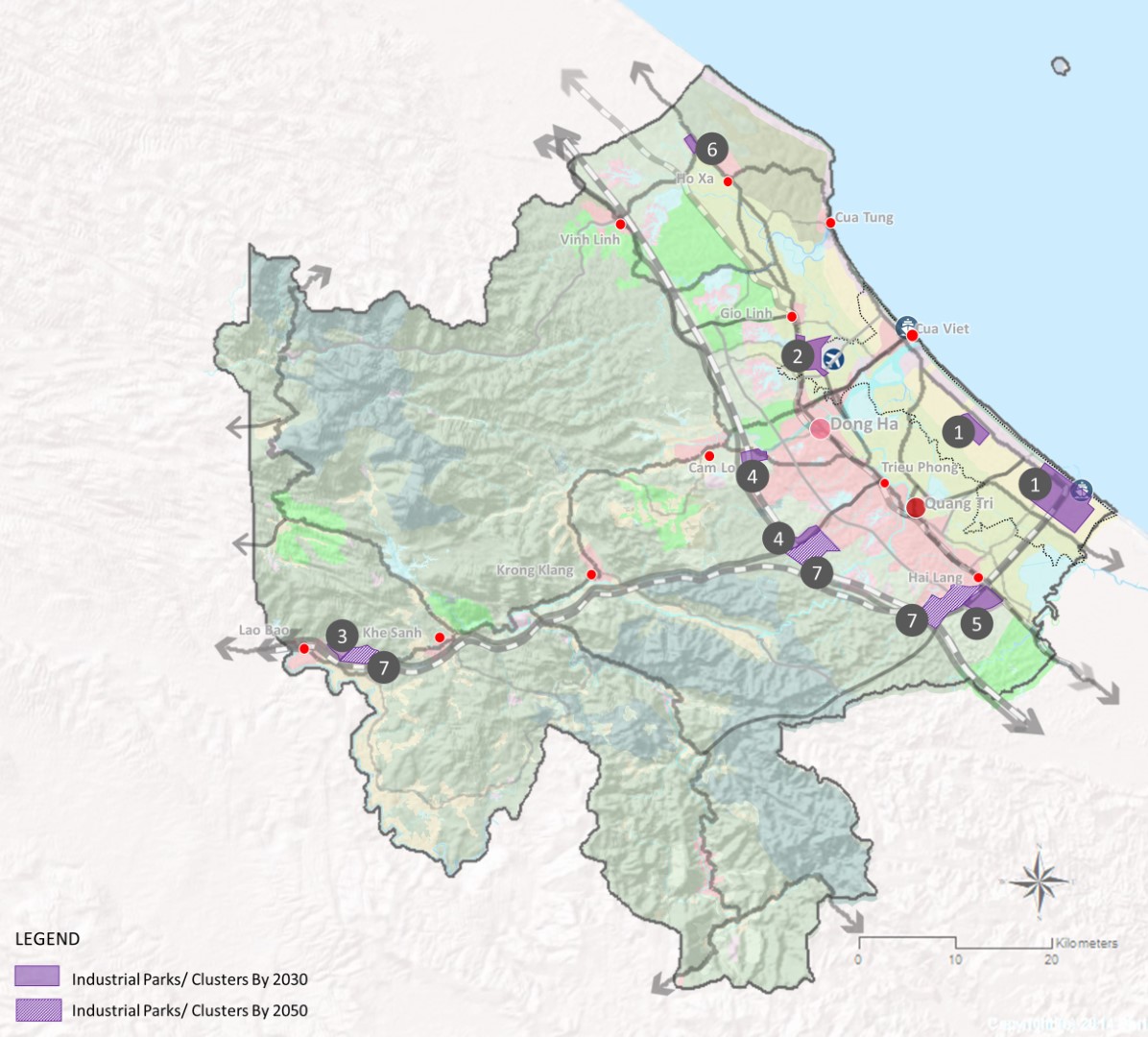
Proposed Industrial Land for 2030 and 2050 In Quang Tri
Tourism Development
With diverse ecology, rich history and a unique
cultural landscape, QT boasts an emerging
tourist destination. To capitalise on its strengths,
the CMP must gear development towards
attracting higher value tourism and increasing
tourists’ duration of stay.
The CMP tourism plan includes preserving
existing cultural and historical sites, as well as
adding new attractions to bolster tourism around
natural splendours and cultural sites alike.
Additionally, the CMP recommended that QT
works with Hue province and Danang to market
collectively a curated program of “Ancient tour of
Hue1
, War history of Quang Tri and modern
entertainment of Danang”.
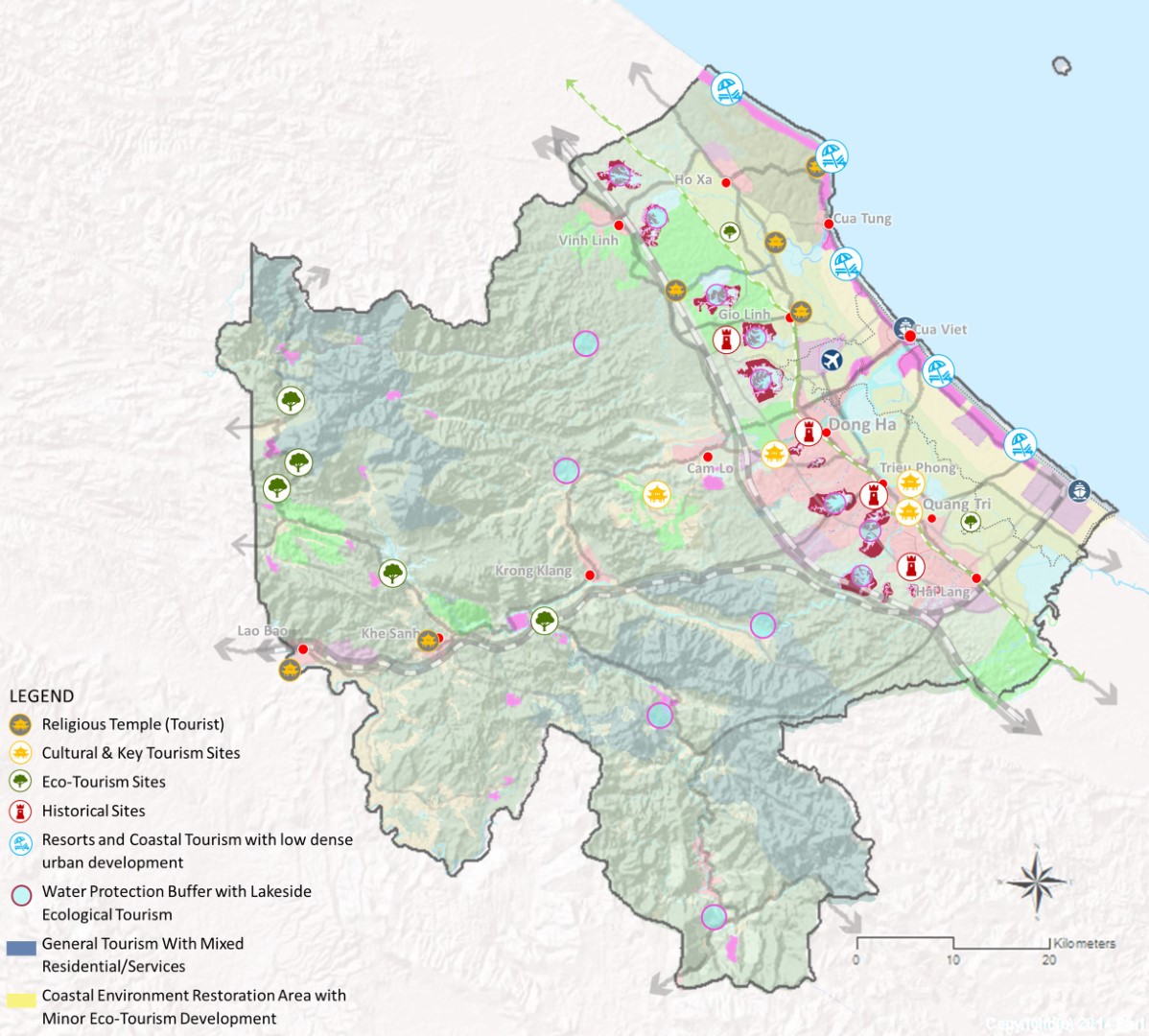
Proposed and Existing Tourism Nodes In Quang Tri
Social Inclusiveness
Rural population (as much as 50% of the
existing population) in QT faces significant
challenges in terms of access to essential
services and job opportunities. Low income, lack
of opportunities and low standard of living led to
brain drain to major cities including Hanoi,
HCMC and Danang.
To address these issues, the CMP proposed to
integrate social inclusiveness with economic
development. By doing so, QT could improve
the quality of life for its residents and energise
its economy at the same time, driving prosperity
and liveability for the region.
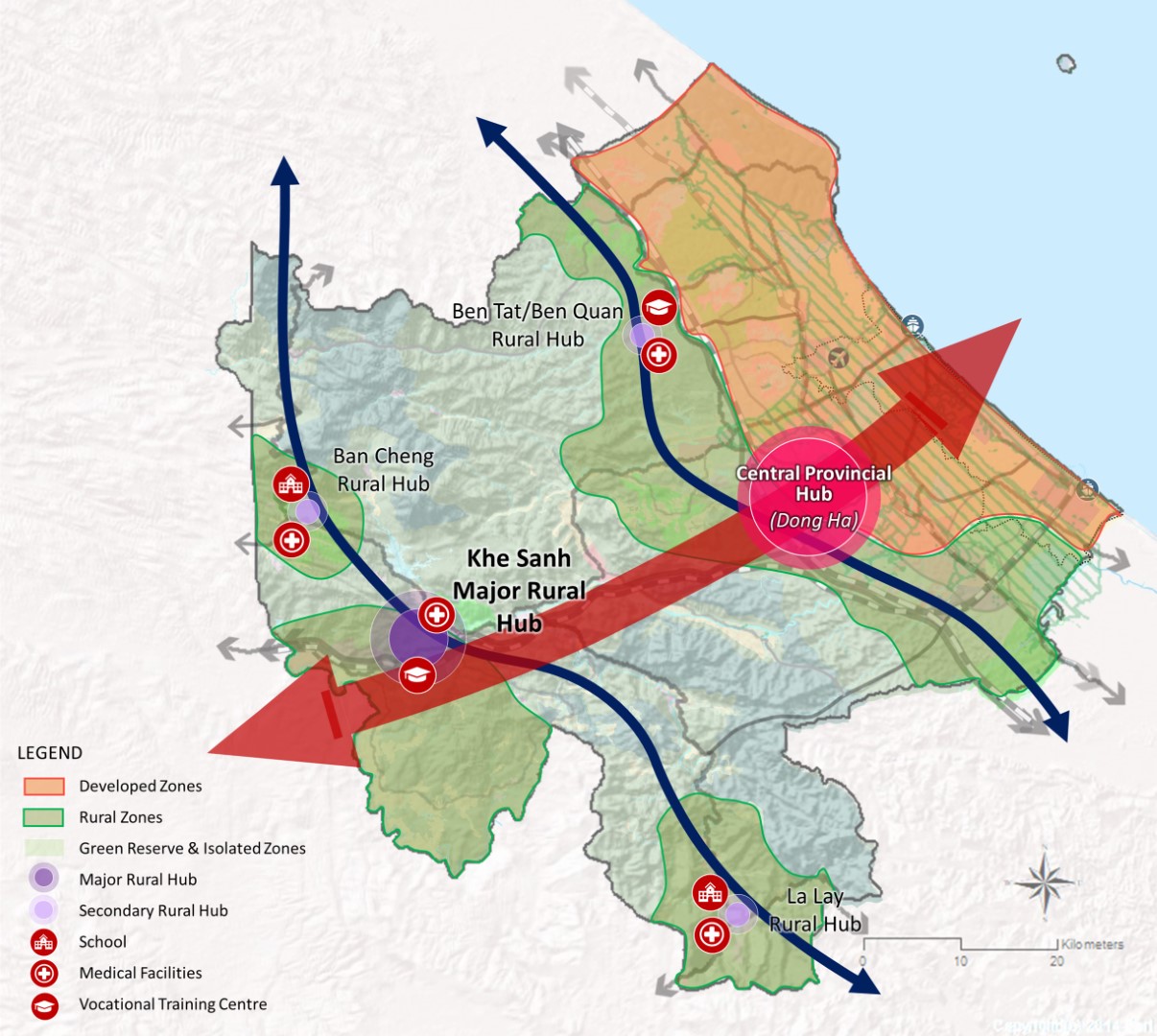
Major Rural Hubs & Rural Areas In Quang Tri
On top of physical improvement, the CMP also proposed gradual investment in essential
infrastructure, ensure access to education, stabilising land usage, improving agriculture, injecting new
types of economic activities and upskilling and training programs in the short to mid-term.
CONCEPT MASTERPLAN
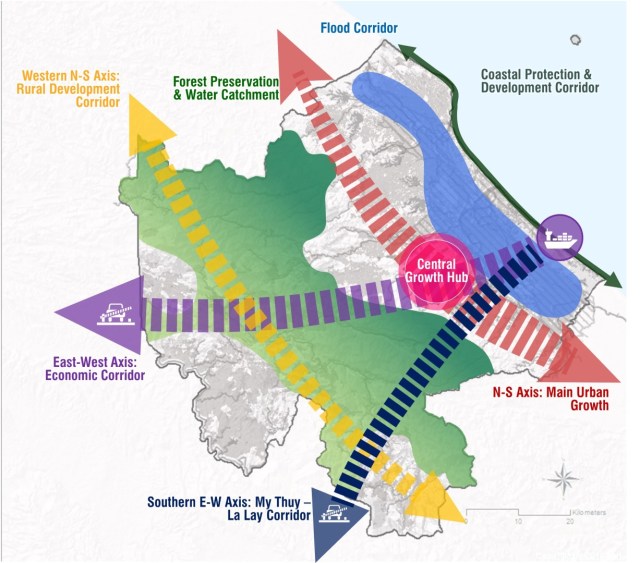
Quang Tri Development Concepts & Growth Axis
Urban expansion
Encompassing the aspirations of the people and the
local government, the Year X Visionary MP is made
to fit the economic projection and the goal of QT’s
development: transforming QT into a “Plentiful
Province”. Tailored to the availability of the land and
its socioeconomic conditions, the MPs – both the
2030 CMP and 2050 Actual MP – are drafted to be
balanced and sustainable. Development along the
various growth axes will increase connectivity and
safeguard the land from disasters. The concept MP
strife to create a balanced & sustainable plan with
One North-South Axis and Two Northern East-West
Axis of Urban and Economic development corridor,
and Two safeguarded corridor for flooding mitigation
and coastal protection.
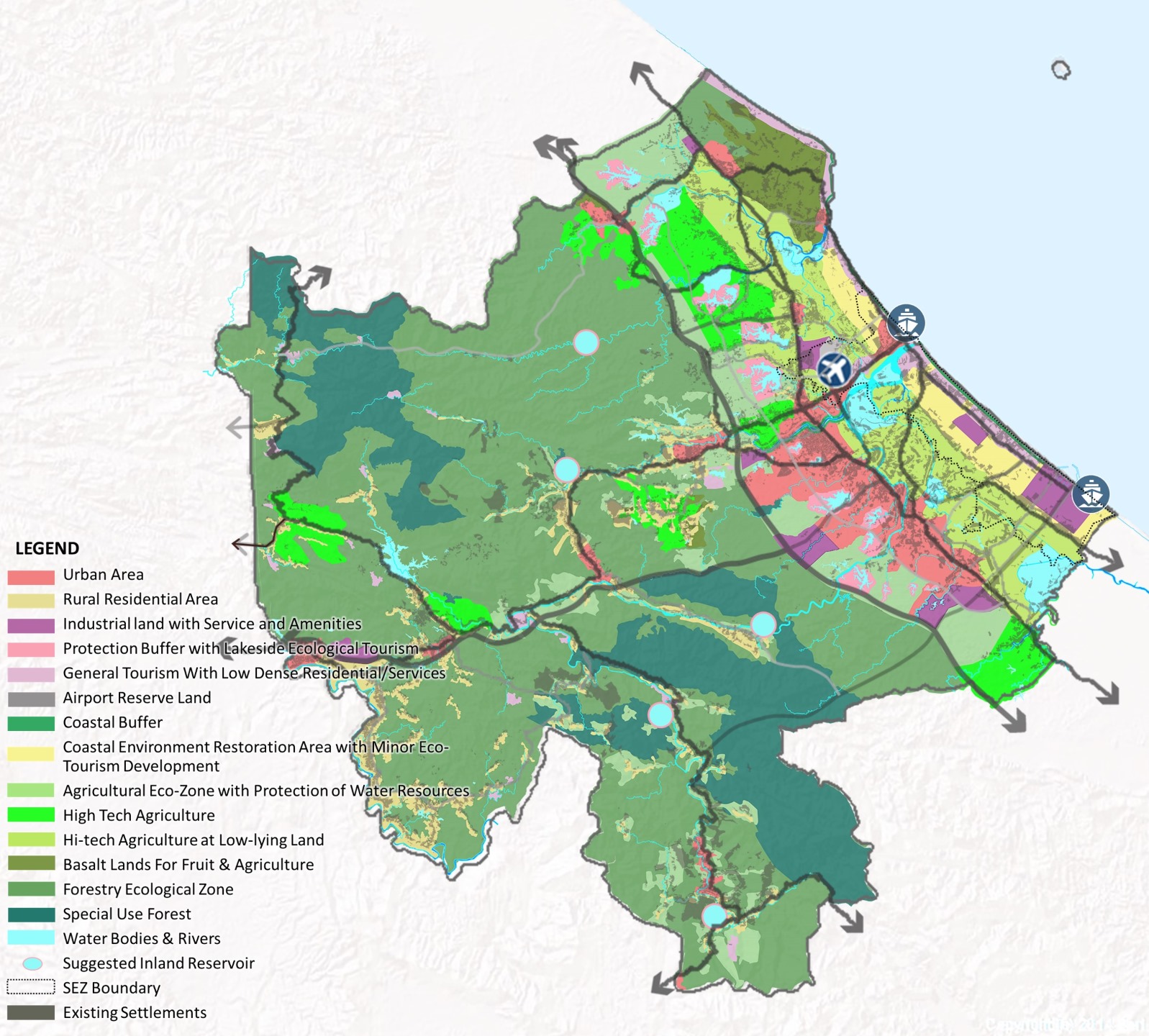
Quang Tri Land Use Plan & Land Distribution By Year X
After expansion, the western dry land would be the new capital city of QT. Other than My Thuy Seaport and committed industrial developments along the coast, the rest of the planned industrial parks will be consolidated and moved back to dry land near urban centres.
Two natural constraint zones (west mountains and flood plains) and a coastal protection corridor were
identified and will be safeguarded. Developments within these zones and corridor are controlled with
recommended guidelines. Secondary urban hubs within the flood plains were carefully identified and
would be protected by dykes if necessary. When possible, new developments in these hubs would be
on higher grounds filled with soil from retention lakes creation.
Transportation
The CMP ensured a well-connected province,
within and to other provinces. The transport
network of roads, air and sea (and reservation)
were planned to satisfy future needs.
Land – Enhanced connection was planned between economic nodes, urban and rural centres facilities. Connection to the other provinces, national roads are enhanced and the upcoming HSR was realigned along the NS expressway corridor to avoid cutting through the province.
Air – An approved new airport was planned to be operational in the next 5 years which would enhance air connection to the rest of Vietnam and the region.
Water transport – Rivers with navigational
potential were identified.
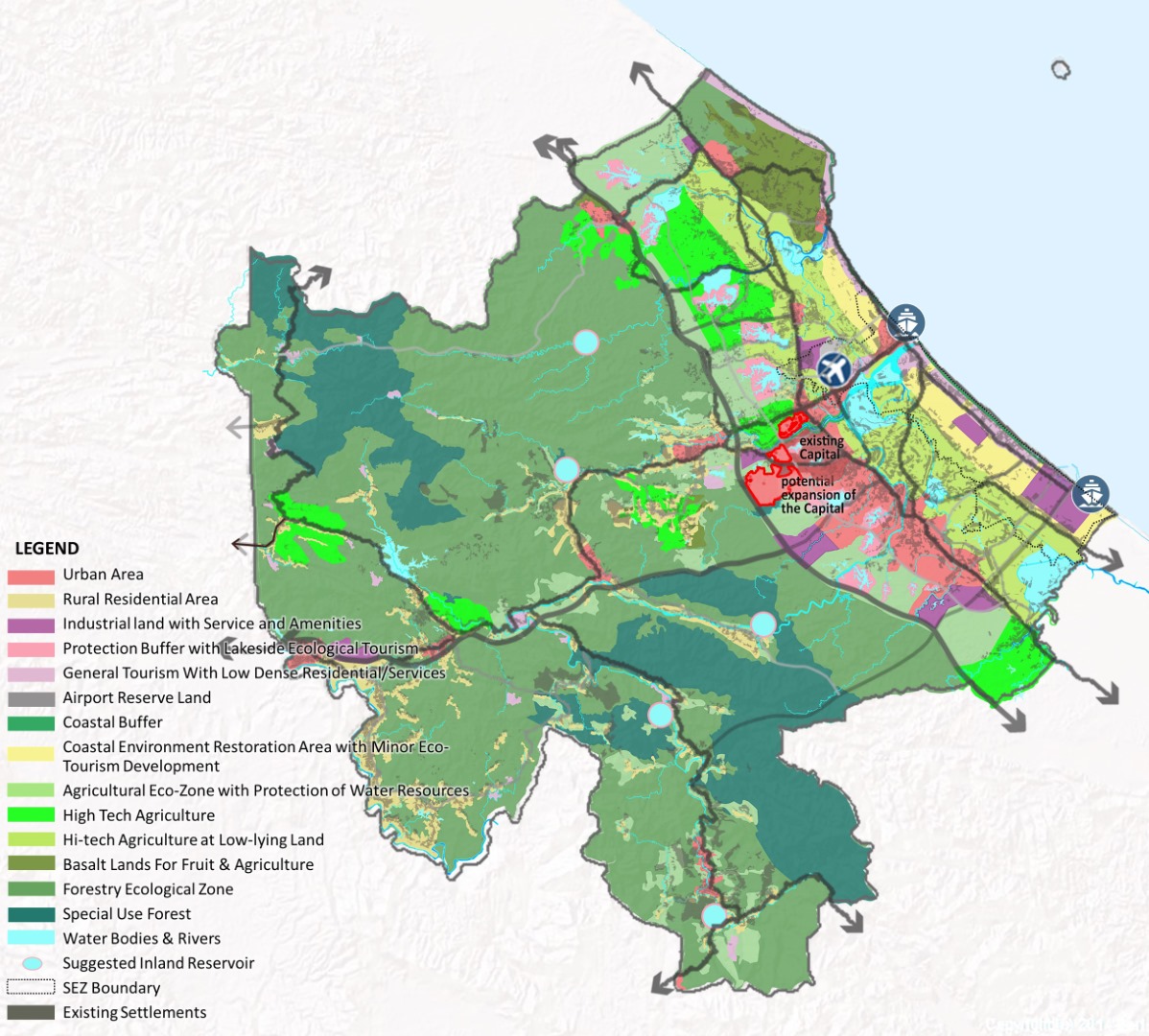
Proposed Transportation Upgrades & Alignment Masterplan for Quang Tri
(Year 2050)
An example of cost-effective vital infrastructure
investment integrated with other economic
benefits is the National Highway No.9 (NH9).
Identified as a vital economic link between
Vietnam and the surrounding nations, an expansion of
the highway entails increased connectivity and
potential for development.
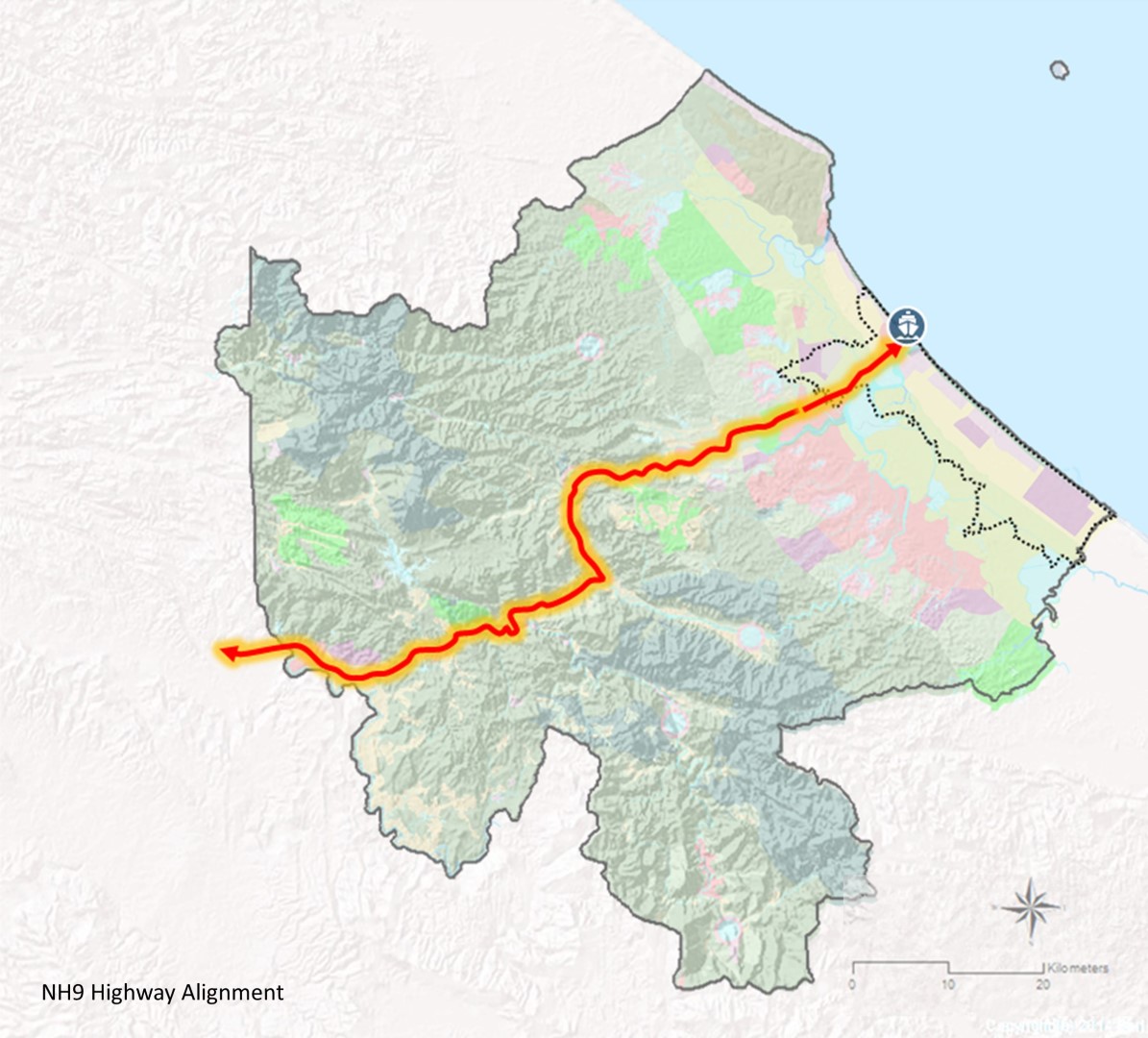
NH9 Highway Alignment
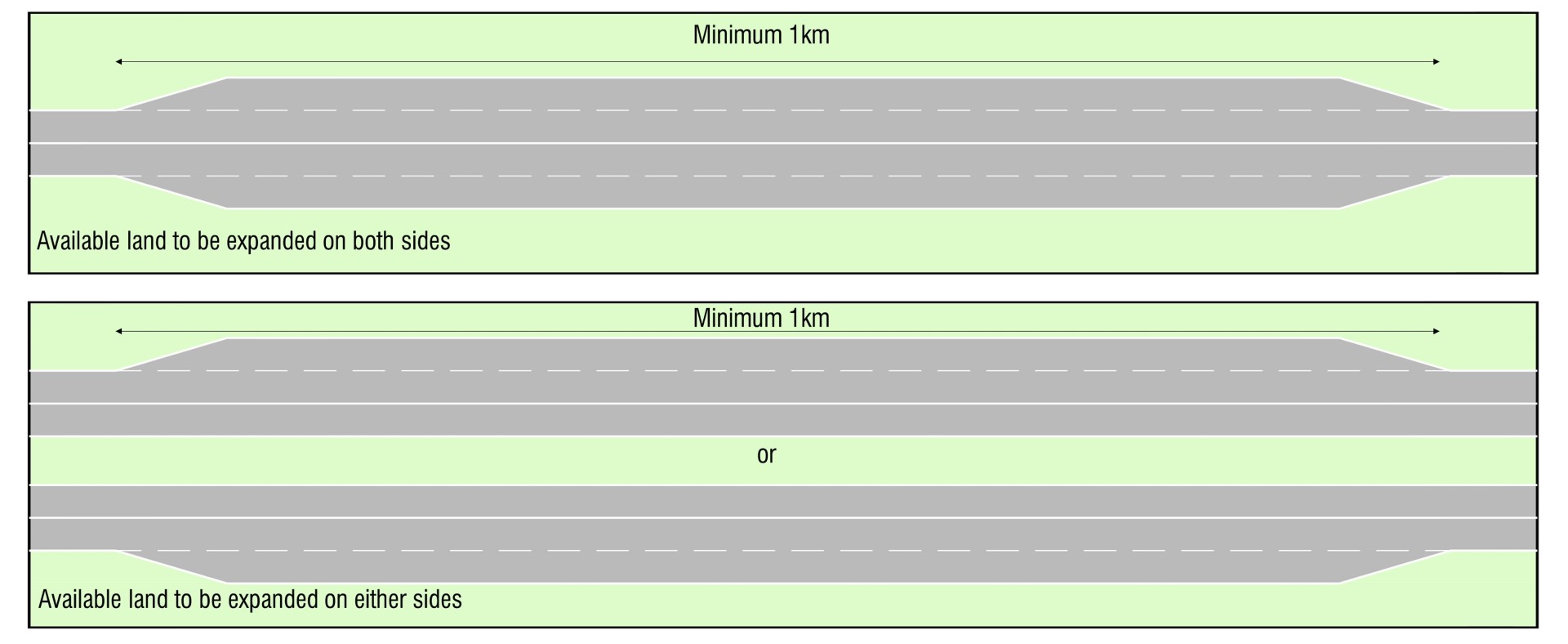
Proposed road adjustment and expansion scenarios in different conditions
OVERALL IMPACT TO THE PROVINCE
The CMP addressed the challenges and took advantages of opportunities presented to improve the
livelihood and quality of life of its citizens while preserving the environment and mitigating disaster
risks. Implemented, it aims to steer QT towards our goal of a “Plentiful Province” with a Vietnamese
model of inclusive and sustainable growth, resilient and secure environment, over the next 30 years.
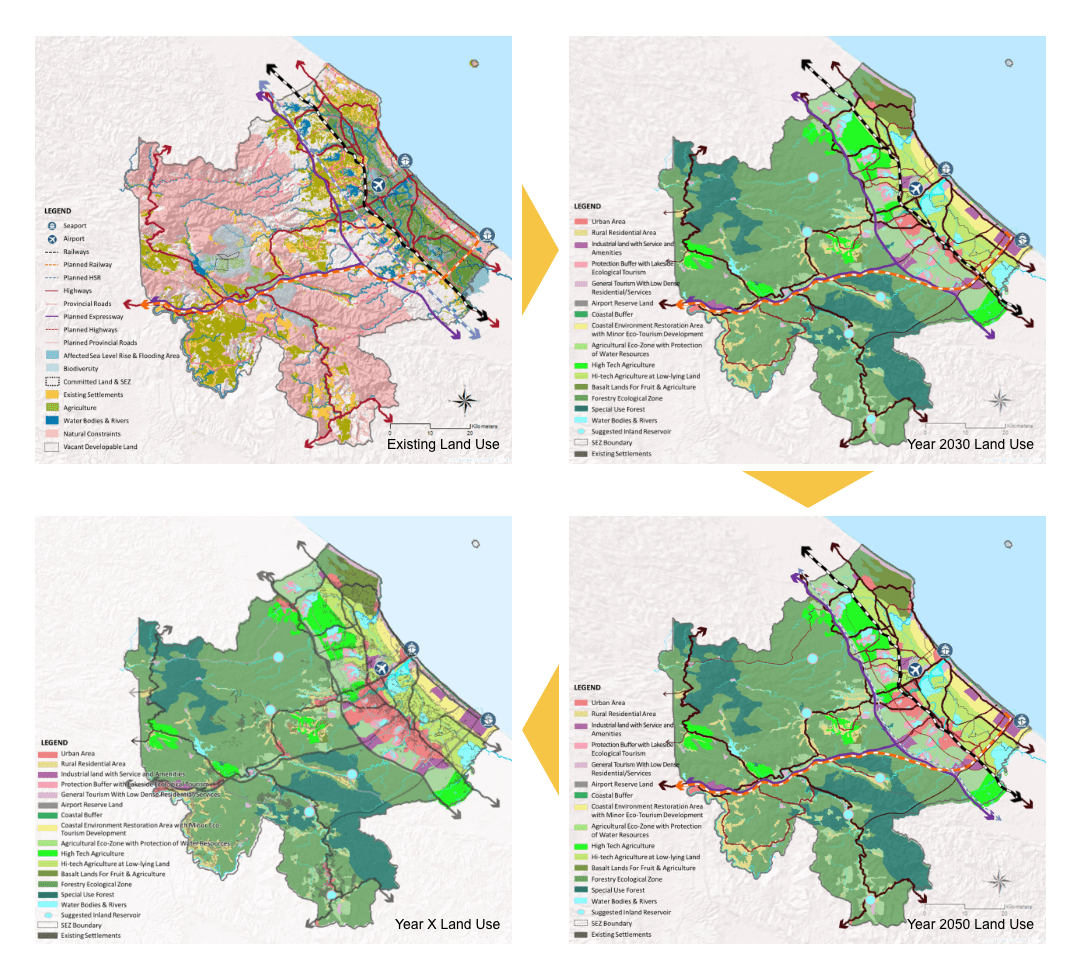
Quang Tri’s Land Use Development from Base Map to Year X
The SEEDS Journal, started by the architectural teams across the Surbana Jurong Group in Feb 2021, is a
platform for sharing their perspectives on all things architectural. SEEDS epitomises the desire of the Surbana
Jurong Group to Enrich, Engage, Discover and Share ideas among the Group’s architects in 40 countries, covering
North Asia, ASEAN, Middle East, Australia and New Zealand, the Pacific region, the United States and Canada.
Articles at a glance





